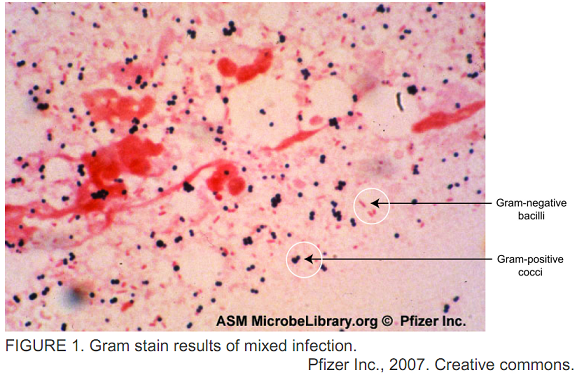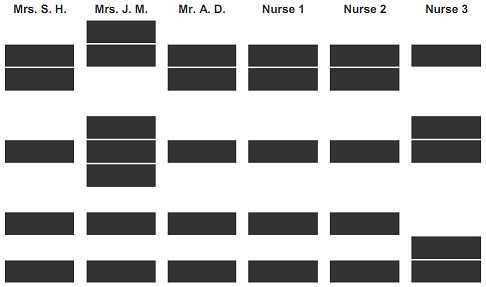Question 1: Write the binomial nomenclature for each of the following descriptions of microorganisms.
a) A gram-positive bacterium that has a low G+C ratio and produces endospores
b) A γ-proteobacterium that commonly inhabits the gastrointestinal tract
c) A member of the Actinobacteria that can cause a disease of the lungs
d) A member of α-proteobacterium that causes crown gall and is used in biotechnology to transfer genes into plants
e. A β-proteobacterium that causes whooping cough
Question 2: A clinical microbiologist wishes to identify two bacterial species from a mixed bacterial skin infection. The microbiologist performed a Gram stain reaction of the sample, and noted by microscopic observation that the sample contains gram-positive cocci in clustered or paired formation and randomly scattered gram-negative bacilli (rods).
The Gram stain results are shown in Figure 1. Using the Photographic Atlas and the textbook, describe the steps the microbiologist will use to a) separate the two organisms, and b) confirm their identity. For each step, explain the rationale for your choices. Hint: The microbiologist has access to selective and differential media as well as biochemical tests.

Question 3: As part of an investigation to identify the course of a respiratory infection among elderly patients at a nursing home, DNA fingerprints were obtained from bacterial isolates of sputum from affected patients and staff. All staff reported not having contracted the illness.
Examine the results of the fingerprint below, and describe the conclusions that can be drawn from the results of the patients and the staff. Which staff members may have spread the illness to which patients? Do all of the patients have the same strain of bacteria? Why do strains of bacteria differ on a DNA fingerprint? Were all staff members tested responsible for infection in all of the patients tested? Why didn't staff members become ill? What can be done to prevent the spread of infection from staff members to patients?

Question 4: Answer the following questions on classification techniques:
a. An increase in the number of cases of necrotizing fasciitis was recently reported in hospitals. Explain how stereotyping would have been used to identify the source of the infection.
b. Discuss how DNA base composition can be used to determine relatedness between organisms.
Question 5: Answer the following questions on α, β, γ, δ, and ε-proteobacteria:
a. Why is the genus Rickettsia an obligate intracellular parasite? Name one disease that is caused by a rickettsia. How is it transmitted?
b. Burkholderia species are capable of degrading many organic molecules. What is the consequence of this ability, and how does this affect humans?
c. Many of the γ-proteobacteria are pathogenic. List two examples, including the genus and species name, and state the disease that they cause.
d. How does the genus Desulfovibrio contribute to the black colour that is present in many soil sediments?
e. Name two genera of ε-proteobacteria, and indicate their relevance.
Question 6: Answer the following questions on Nonproteobacteria, Gram-positive bacteria, other Gram-negative phyla, and the Archea.
a. Describe how Cyanobacteria use water in photosynthesis, and compare this process to the use of H2S by purple sulfur bacteria.
b. What growth characteristic does Staphylococcus aureus possess that contributes to it being a common food pathogen? What characteristic of this organism makes it a problem in hospitals?
c. State the morphology, habitat, and unique characteristic common to Bacillus species.
d. Briefly describe the mechanism of motility in spirochetes.
e. What features distinguish Domain Archaea from other bacteria?
Question 7: Column B lists terms related to fungi and yeasts. Column A provides descriptions of the terms or organisms. For each description in Column A, select the answer from Column B.
|
Column A
|
Column B
|
|
Sac containing asexual spores
|
a. zygospore
|
|
Ability to become pathogenic
|
b. hypha
|
|
Vegetative fungal structure
|
c. mutualistic
|
|
Result of mating two different strains
|
d. septum
|
|
Asexual spore
|
e. sporangium
|
|
Reproductive process used by yeasts
|
f. mycosis
|
|
Partnered growth between fungi and algae
|
g. ascospore
|
|
Enclosed by a thick wall
|
h. opportunistic
|
|
Fungal infection
|
i. budding
|
|
Hyphal cross-wall
|
j. conidium
|
Question 8: Answer the following questions on fungi and algae:
a. Certain fungi are known to have positive and negative effects in nature. Use two examples of fungi to outline such effects.
b. What is lichen? What type of relationship does this demonstrate? How does each organism contribute? Give an example of the importance of lichens.
Question 9: Define the term mycosis, and differentiate between systemic mycosis, subcutaneous mycosis, and superficial mycosis. If a person contracted a fungal disease that was caused by the group of fungi known as dermatophyte, what type of mycosis would this be? Why is this group of fungi able to cause this type of infection and how it is usually transmitted?
Question 10: What is an opportunistic pathogen? Give an example of an opportunistic mycosis.
Question 11: What is an algal bloom?
Question 12: Briefly outline the life cycle of Plasmodium sp. What stage of the life cycle results in fever and chills in the infected host and why?
Question 13: What is a vector? Give an example of a vector-borne disease and name the vector responsible for transmission.
For all the students of this university, who are often struggling with their assignment tasks, allocated by the university professors, Binomial Nomenclature Assignment Help service is the best place to avail online assistance.
Tags: Binomial Nomenclature Assignment Help, Binomial Nomenclature Homework Help, Binomial Nomenclature Coursework, Binomial Nomenclature Solved Assignments, Life Cycle Assignment Help, Life Cycle Homework Help, Opportunistic Pathogen Assignment Help, Opportunistic Pathogen Homework Help, Microorganisms Assignment Help, Microorganisms Homework Help